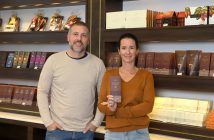The new undertaking will combine factory, coffee shop and Chocolate museum
If it were not so difficult to undertake in Brazil, with so many duties, bureaucracies and extortionate taxes, Arcelia Gallardo, born American, would have chosen to set up her new dream here. But it is tough!
Thus, by the end of the year, in October, Arcelia will go back to Los Angeles, California, which she left around 5 years ago with her husband, to set up a new factory, this time around five times larger than the one she has at home, in São Paulo. The new factory will also include a coffee shop and a Chocolate Museum focused on education. The idea is to provide several courses and travels to cacao producers worldwide. In addition to exhibitions, for example, a collection of stone machines where Aztecs produced their chocolates.
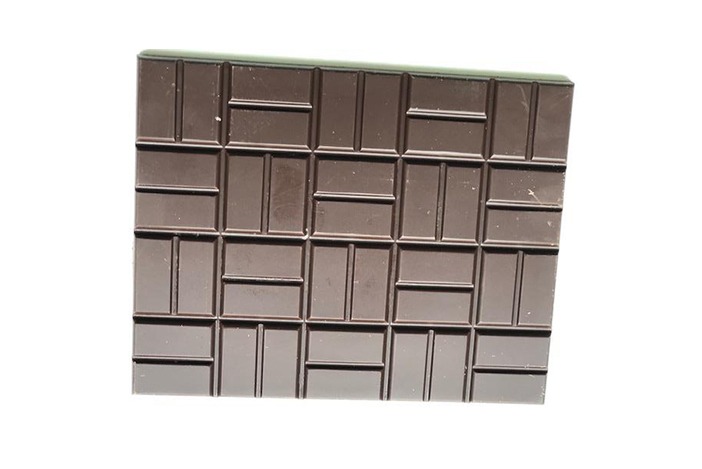
Mission Chocolate
Besides taking the country in her heart, she returns with two little Brazilian girls, her daughters. “My life will be there and here, I won’t interrupt my activities in Brazil. We have permanent visa, so we will figure out a way to spend part of the year here”, she says.
To confirm that, she says that she is negotiating a partnership with Mestiço Chocolate, www.mestiçochocolates.com.br, partner in her courses, so that her recipes will be manufactured by the brand. “My factory in California will be exclusively dedicated to supply the American market”, she informs.
How everything started
Her parents are from Colina, Mexico, where they worked in farms, breeding animals and planting avocado and lemon. They immigrated to the USA in 1974 and went to live in Los Angeles where they worked in several factories, sometimes producing K7 tapes (who remembers?), other times Christmas balls, or belts for cars. It means that where there was decent work, they were there.
With the six children already grown and graduated, they bought in 1992 a farm in California, in Fresno, distant four hours, towards Los Angeles North and today, retired, they plant plums and apricots. By the way, the city is famous for its fairs of organic food which, no doubt, influenced Arcelia’s whole work.
Before becoming interested in chocolates, Arcelia studied marketing at Berkeley www.berkeley.edu, one of the most important and prestigious universities worldwide. “At that time, I would only eat Twix, I ate it a lot and thought it was the best chocolate produced. Years later I found out that I really liked sugar, rather than chocolate”, she recalls.
Her first job was at gastronomy school Le Cordon Bleu, www.cordonbleu.edu, in LA, where she started to become seriously interested in chocolate. She came to know about Schaffer & Berger, first Bean to Bar chocolate factory in the USA in a work meeting and decided to go to the tour they offered to the public to show how they prepared their chocolates. “It was there that I noticed that what I used to eat was not chocolate”, she tells.
When Cordon Bleu closed, Arcelia, who already prepared sweets for friends on weekends, decided to really invest and set up a sweet-shop. After one and a half year, she decided that it was time to start a new phase and produce her own chocolate. However, the local health legislation did not permit production of food in the district, food could only be sold.
At the same time, her husband, Puerto Rican American, received a proposal from Morgan Stanley investments bank, where he already worked, to move to Mexico or Brazil.
The couple opted for Brazil, since the market was larger and more promising for them. Arcelia saw in the move a great opportunity to learn more about the Brazilian cacao, and get to know cacao farms.
Having decided to move, Gallardo sold her shop and started to get prepared for the travel. However, her visa, which should have been ready quickly, took a year. During this time, as she couldn’t stand still, she discovered Dandelion www.dandelionchocolate.com,
one of the main Bean to Bar chocolate factories in the USA. “Every time I left my apartment in San Francisco I would pass in front of Dandelion. In the beginning, when they moved to the neighborhood, they placed a sign that draw a lot of attention, which said: “Chocolate Factory coming soon”. The shop was finally open, and as she was doing nothing, just waiting, one day she decided to enter the factory and ask for a job. She learnt to make chocolate and also travelled to cacao farms. “I learnt the whole process”, she says.
Arrival in Brazil
When her visa was finally ready, she and her husband came to Brazil and Arcelia started to produce her Bean to Bar chocolates in her apartment in Itaim. “It was small and, in order to produce, I separated the cold process from the hot one and went to sell it at a small fair in Butantã, where today is Vila Butantan, at the end of Francisco Morato avenue. I rented a small space for four weekends and, to my surprise and disappointment, I didn’t sell anything!!! Nobody had ever heard of Bean to Bar in Brazil, they thought prices were too high and I had to give up. But I understood that Brazilians should be educated, and I had to help create the market”, she observes.
Then she started to promote degustation of imported chocolates and people who were already interested in the area or who already worked with chocolates started to appear, like Bruno Lasevicius, from Casa Lasevicius, Cláudia Landman, from Chocolate du Jour, among others. It was a public eager for novelties and wanting to know what was going on around the world in terms of quality chocolate.
And so Arcelia began to help several chocolate makers, as well as cacao producers, who were eager to improve Brazilian cacao quality standard. One of them was Rogério Kamei, from Mestiço Chocolate, producer in Bahia south region, Itacaré, owner of Fazenda Bonança, who was already helping other producers to ferment better, dry less, and also testing the chocolate in his factory.
“I brought to Brazil the expert from Hawaii Daniel O’Doherty, from Cacao Services, www.cacaoservices.com, who came to visit farms and provide consultancy. Juliana Aquino, from Baiani, hired him later for her farm, Vale Potumuju, and kindly opened her property for other producers of the region to learn how to make fine cacao, special cacao” she recalls.
From these actions, Bean to Bar movement and the association were born. Arcelia is the association’s president. “Around three years ago, no respectful chocolate maker in the world would come to Brazil to visit or buy cacao. They used to go to Peru or Belize, in Central America. We could change people’s perceptions on the quality of native cacao and the result is that many Brazilian chocolate makers are being awarded in international contests, and professionals from other countries now prefer to use Brazilian cacao”, she comments.
New projects
As soon as she returns to the USA, she intends to open her factory and then her coffee shop. For both undertakings she already counts on the necessary capital. To open the Chocolate Museum, however, whose opening is expected for 2022, she must attract investors to make the project feasible. “I will have a school to teach cacao and chocolate history, and teach how to make true chocolate. We will visit farms in Brazil, Venezuela, Mexico, Peru, etc., wherever there is good production of fine cacao, we will be there!
The Brazilian culinary legacy in chocolates
As a foreigner that learnt to love and appreciate Brazil, Arcelia has used genuinely Brazilian ingredients in her bars’ recipes. Proof of that is her line of Brazilian Deserts, comprising flavors like Sweet Rice, Goiabada (guava paste), Romeo and Juliet, gingerbread, and Pamonha (corn paste wrapped in husks). For this year, she will launch a chocolate bar with farofa (manioc flour mixture). “It takes me months to research flavors, I visit producers, study in books of Brazilian recipes, I go for it. Everything happened because I saw that the whole Bean to Bar market was doing the same thing. And Brazil counts on the largest diversity in the world, so why not use it? I tasted goiabada for a whole year to find the right one and put in my bars”, she recalls.
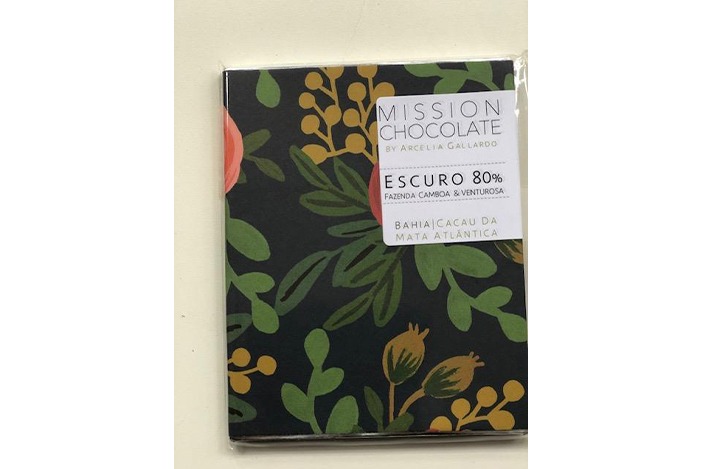
Mission Chocolate – Linha Sobremesas Brasileiras
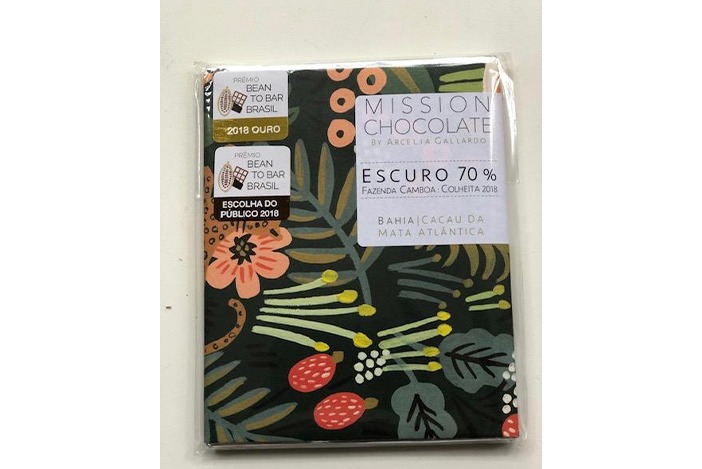
Mission Chocolate – Linha Sobremesas Brasileiras

Mission Chocolate – Linha Sobremesas Brasileiras
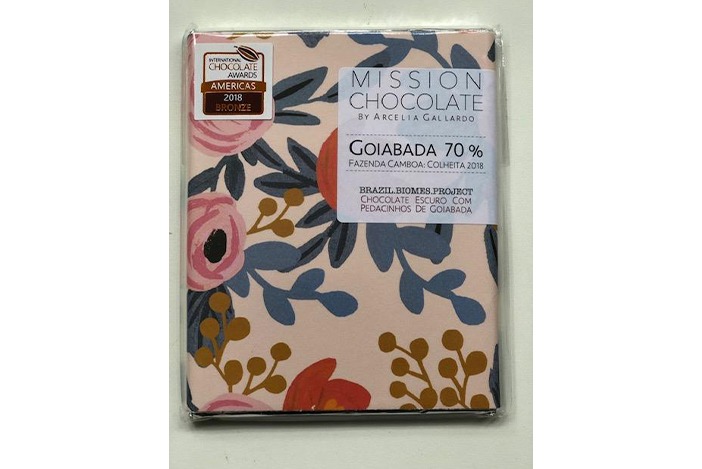
Mission Chocolate – Linha Sobremesas Brasileiras
Mission Chocolate also has a line called Brazilian Biomes, with fruits like Cupuaçu, Pequi, Licuri, Baru etc., unknown even to Brazilians. “Baru is the fruit of the Baru tree, large tree from Brazilian Cerrado, which produces a delicious nut that only exists here.
As we can see, ingredients to create bars, with 70%, 80% and 90% of cacao was never a problem, except for milk. “Quality powdered milk is the most difficult ingredient in Brazil. In the USA, it’s easy to find organic milk, fresh, vegan, of any type. I would like to produce more milk chocolate, or white chocolate, a little sweeter, to please Brazilians’ taste”.
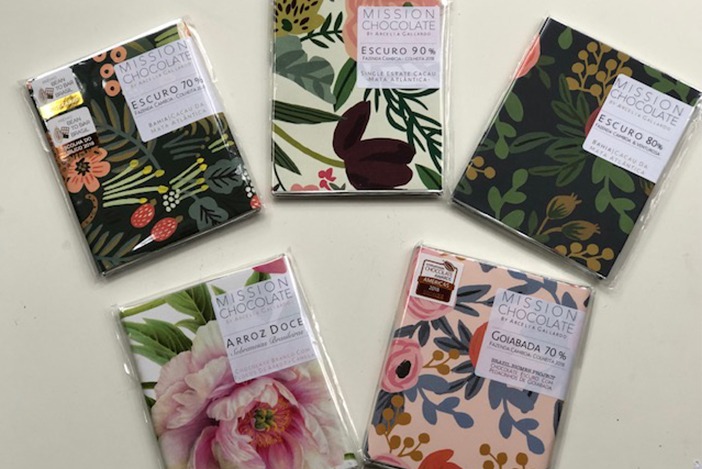
Mission Chocolate – Linha Sobremesas Brasileiras

Mission Chocolate – Linha Sobremesas Brasileiras
Did it make your mouth water? Would you like to taste these delights? Then I have good news and bad news. The brand website www.missionchocolate.com is not selling products now. If you are in Brazil, you will find your chocolates in LojaMod, www.mod.com.br, Casa Santa Luzia, www.santaluzia.com.br, Chocolateria Origens, www.origenschocolateria.com.br, in Santos.
In the USA, however, you can go to Chocolate Covered, www.Chocolatecovereddsf.com(San Francisco), Monsieur Marcel, www.monsieur-marcel.business.site (Los Angeles), Roni-Sue’s Chocolates, www.Roni-sue.com (NY), Raphio Chocolate, www.raphiochocolate.com, (Fresno) and Chocopolis, www.chocopolis.com (Seattle).


